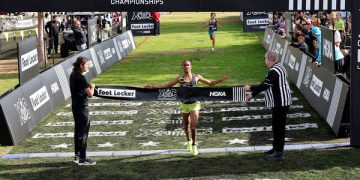Christian Coleman is the 2019 World Outdoor Champion at 100m. He is also the 2018 World Indoor Champion at 60m. I have interviewed Christian Coleman on several occasions. He seems to be a nice guy.
 Christian Coleman, photo by Mike Deering / The Shoe Addicts
Christian Coleman, photo by Mike Deering / The Shoe Addicts
This is not about Christian Coleman being a nice guy. This is about how Christian Coleman, who had one near ban on the same whereabouts issues a year ago, took a rather reckless attitude towards Whereabouts testing. His current possible ban was totally avoidable, in my estimation.
On the date, December 9, 2019, Christian noted that he could be contacted on Whereabouts protocals between 7:15 PM and 8:15 PM. He was not where he was supposed to be?
The ramifications are huge. The top male sprinter, going into an Olympic season, will probably be banned. It could have been avoided. Management did not do their job. Christian Coleman did not do his job. And it casts a shadow on his career in particular and sprinting in general. No one wins.
Why was he not at home? Why did he have to go to a Walmart Superstore then? Who was there to remind him that, even a 100m World Champion needs to do the Whereabouts protocals.
Considering what Nike allegedly was paying Mr. Coleman, his management team should have had some involvement in keeping Coleman on task. This will cause both some changes in the world of money.
This was just plain sad. It could have been avoided.
As a public service, I have posted the Whereabouts protocals below.
WHEREABOUTS (https://www.wada-ama.org/en/questions-answers/whereabouts)
What are whereabouts?
Why are whereabouts important for clean sport?
Where can whereabouts rules be found?
Are all athletes subject to these whereabouts requirements?
Do athletes have to provide and update their whereabouts information themselves?
Do Anti-Doping Organizations only test athletes who are subject to whereabouts requirements?
1. WHAT ARE WHEREABOUTS?
Whereabouts are information provided by a limited number of top elite athletes about their location to the International Sport Federation (IF) or National Anti-Doping Organization (NADO) that included them in their respective registered testing pool as part of these top elite athletes’ anti-doping responsibilities.
2. WHY ARE WHEREABOUTS IMPORTANT FOR CLEAN SPORT?
Because out-of-competition doping controls can be conducted without notice to athletes, they are one of the most powerful means of deterrence and detection of doping and are an important step in strengthening athlete and public confidence in doping-free sport. Accurate whereabouts information is crucial to ensure efficiency of the anti-doping programs, which are designed to protect the integrity of sport and to protect clean athletes.
The concept of out-of-competition is not new. Experience has shown that out-of-competition testing is crucial to the fight against doping, in particular because a number of prohibited substances and methods are detectable only for a limited period of time in an athlete’s body while maintaining a performance-enhancing effect. The only way to perform such testing is by knowing where athletes are, and the only way to make it efficient is to be able to test athletes at times at which cheaters may be most likely to use prohibited substances and methods.
3. WHERE CAN WHEREABOUTS RULES BE FOUND?
Whereabouts rules are part of the International Standard for Testing and Investigations (ISTI). The ISTI is mandatory for Anti-Doping Organizations (ADOs, including IFs, NADOs, Major Games Organizers, etc.) that have adopted the World Anti-Doping Code (the document harmonizing anti-doping rules in all sports).
4. ARE ALL ATHLETES SUBJECT TO THESE WHEREABOUTS REQUIREMENTS?
No.
Whereabouts requirements are for the limited number of top-level athletes who are in the registered testing pool of either their IF or NADO. They were designed to give those top-level athletes a flexible tool to show their commitment to doping-free sport, as well as appropriate, sufficient and effective privacy protection.
WADA is not responsible for deciding who should be part of these registered testing pools. IFs are afforded discretion as to who should be subject to these provisions internationally, and NADOs are afforded discretion to create a registered testing pool at the national level. It is WADA’s recommendation that registered testing pools be of proportionate and manageable size and focus on top international and national elite athletes.
5. DO ATHLETES HAVE TO PROVIDE AND UPDATE THEIR WHEREABOUTS INFORMATION THEMSELVES?
Athletes can have their agent or another representative submit their whereabouts information if they wish to. In team sports, whereabouts information can be submitted by team officials on a collective basis as part of the team’s activities.
However, athletes are ultimately responsible for their whereabouts. As a result, they cannot avoid responsibility by blaming their representative or the team for filing inaccurate information about their whereabouts or for not updating their whereabouts if they were not at the location specified by them during the 60-minute time-slot.
6. DO ANTI-DOPING ORGANIZATIONS ONLY TEST ATHLETES WHO ARE SUBJECT TO WHEREABOUTS REQUIREMENTS?
No.
Whereabouts requirements are a practical tool to help ADOs conduct effective out-of-competition testing. Irrelevant of whether they have been selected to be part of a registered testing pool, athletes can still be tested out-of-competition by their IF, their NADO or other ADOs.
What are Whereabouts Failures? (USADA.org)
Education, Spirit of Sport / March 4, 2019
Whereabouts requirements aren’t always easy or convenient, but accurate and complete Whereabouts information is critical to USADA’s ability to conduct the no-notice, out-of-competition testing that is part of an effective anti-doping program. Out-of-competition testing helps protect clean sport and deter doping by eliminating times that athletes know they won’t be tested and may otherwise use performance-enhancing drugs.
Athletes in the USADA Registered Testing Pool (RTP) are required by the World Anti-Doping Agency (WADA) Code to submit quarterly Whereabouts and provide Whereabouts updates on an ongoing basis to ensure that they can be located for testing. RTP athletes must provide a full address for their overnight location, and the name and full address of each location where they train, work, or conduct other regular scheduled activities, as well as the usual time-frames of each activity. RTP athletes must also identify a 60-minute window and location for each day of the quarter, during which they must be available for testing.
The World Anti-Doping Code requires that athletes comply with Whereabouts and testing obligations, and failure to comply with an obligation will result in a Whereabouts Failure.
Are there different Whereabouts Failures?
There are two types of Whereabouts Failures: Filing Failures and Missed Tests.
1. Filing Failure
If an RTP athlete does not file the required Whereabouts information by the quarterly deadline, they are subject to a Filing Failure,
which is one type of
Whereabouts Failure. Filing Failures can also be issued if the information provided in the initial Whereabouts filing is insufficient or
inaccurate (i.e., full
addresses, dates, or 60-minute windows are missing).
Highlighting the importance of accurate and complete Whereabouts, a Filing Failure may also be issued if a Doping Control Officer (DCO)
makes a reasonable attempt to test an athlete at the locations provided on an athlete’s Whereabouts filing and the athlete cannot be
located or confirms they are unavailable.
While Whereabouts do require time and diligence, RTP athletes can sign up for weekly or daily texts or emails if they need additional
reminders about the status of their Whereabouts information.
2. Missed Test
RTP athletes can be subject to a Missed Test, which is a second type of Whereabouts Failure, if they are not available for testing
during the 60-minute window they have provided on their Whereabouts filing. Importantly, a Missed Test can only be issued if an attempt
is made at some point during the identified 60-minute window and the athlete is unavailable.
What is an Unsuccessful Report?
USADA may attempt to test athletes on dates and times outside of the times designated in Whereabouts information. If a DCO makes a
reasonable attempt to locate an athlete for no-notice testing and the athlete is not able to be located, or the athlete confirms they are
unavailable, the DCO will fill out an Unsuccessful Report Form and submit that to USADA.
This form may also be completed if the athlete is not at the location designated in their Whereabouts filing, which may lead to a
Whereabouts Failure. Additionally, this form may be submitted if the athlete could accommodate the DCO’s request to test them
but refuses to submit to testing, which may lead to an Anti-Doping Rule Violation (ADRV). The Unsuccessful Report documents the
locations and times the DCO attempted to locate the athlete, as well as any additional information regarding the attempt, including
phone calls placed or if they had contact with any other individual.
Once the Unsuccessful Report Form is submitted to USADA and reviewed, a decision is made whether to issue an initial Filing
Failure or Missed Test, or to begin a case for an anti-doping rule violation. If a Filing Failure or Missed Test notice is issued to an
athlete, the Unsuccessful Report Form will be included in their notification of the Whereabouts Failure.
Can an athlete get an Anti-Doping Rule Violation for Whereabouts Failures?
Yes. Any cumulation of three Missed Tests or Filing Failures in a 12-month period can result in a potential ADRV and a
period of ineligibility of up to two years for a first violation.
Want more information?
For questions about testing and Whereabouts, call Athlete Express at (866) 601-2632 or email AthleteExpress@USADA.org.
Author

Larry Eder has had a 52-year involvement in the sport of athletics. Larry has experienced the sport as an athlete, coach, magazine publisher, and now, journalist and blogger. His first article, on Don Bowden, America's first sub-4 minute miler, was published in RW in 1983. Larry has published several magazines on athletics, from American Athletics to the U.S. version of Spikes magazine. He currently manages the content and marketing development of the RunningNetwork, The Shoe Addicts, and RunBlogRun. Of RunBlogRun, his daily pilgrimage with the sport, Larry says: "I have to admit, I love traveling to far away meets, writing about the sport I love, and the athletes I respect, for my readers at runblogrun.com, the most of anything I have ever done, except, maybe running itself." Also does some updates for BBC Sports at key events, which he truly enjoys. Theme song: Greg Allman, " I'm no Angel."
View all posts



















